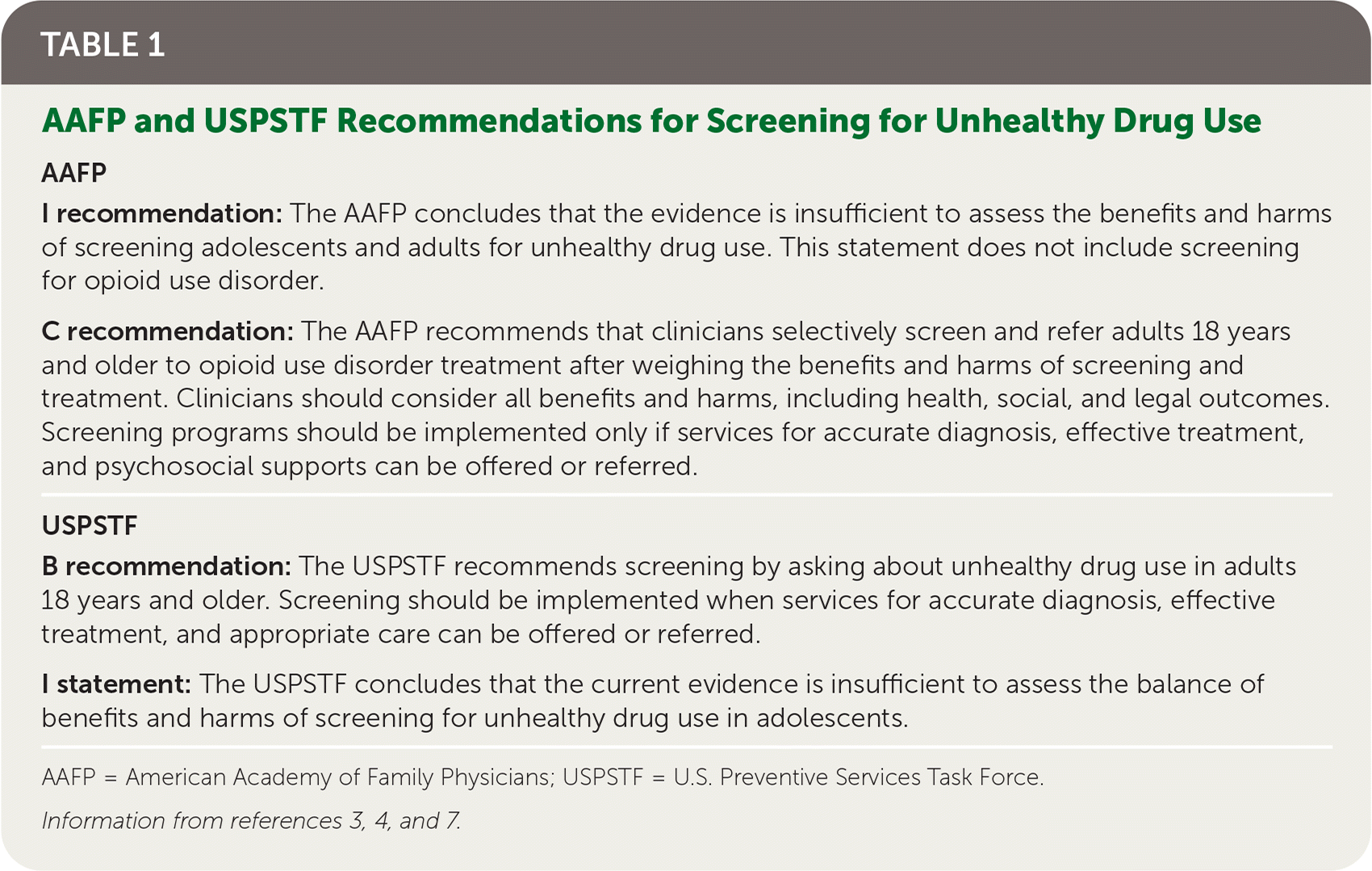
Am Fam Physician. 2021;103(2):72-73
Related USPSTF: Screening for Unhealthy Drug Use: Recommendation Statement.
Related letter: Primary Care Is Essential in Screening, Treating, and Referring People for Unhealthy Drug Use
Author disclosure: No relevant financial affiliations.
Substance use disorders (SUDs) are highly prevalent and dangerous. The 2018 National Survey on Drug Use and Health found that 20.3 million people 12 years and older had an SUD and that 10.3 million individuals older than 12 years misused opioids within the previous year.1 In 2017 in the United States, 70,237 individuals died from a drug overdose.2
To address this growing problem, the U.S. Preventive Services Task Force (USPSTF) recently updated its recommendations on screening for unhealthy drug use in adults and adolescents. For the first time, the USPSTF recommends screening adults 18 years and older by asking about unhealthy drug use.3 It issued an I statement (insufficient evidence) regarding screening for adolescents.3 In response, the Commission on Health of the Public and Science of the American Academy of Family Physicians (AAFP) reviewed the recommendation and the supporting evidence.4–6 The AAFP agrees that there is insufficient evidence to screen adolescents for unhealthy substance use but disagrees that there is sufficient evidence to assess the benefits and harms of screening in adults, except for opioid use disorder (OUD; Table 1).3,4,7

| AAFP |
| I recommendation: The AAFP concludes that the evidence is insufficient to assess the benefits and harms of screening adolescents and adults for unhealthy drug use. This statement does not include screening for opioid use disorder. |
| C recommendation: The AAFP recommends that clinicians selectively screen and refer adults 18 years and older to opioid use disorder treatment after weighing the benefits and harms of screening and treatment. Clinicians should consider all benefits and harms, including health, social, and legal outcomes. |
| Screening programs should be implemented only if services for accurate diagnosis, effective treatment, and psychosocial supports can be offered or referred. |
| USPSTF |
| B recommendation: The USPSTF recommends screening by asking about unhealthy drug use in adults 18 years and older. Screening should be implemented when services for accurate diagnosis, effective treatment, and appropriate care can be offered or referred. |
| I statement: The USPSTF concludes that the current evidence is insufficient to assess the balance of benefits and harms of screening for unhealthy drug use in adolescents. |
The AAFP assessed the strengths and weaknesses of the two systematic reviews commissioned by the USPSTF, potential benefits and harms of screening, and the effect of screening on health equity and practice. Although multiple validated screening tools are available, there have been no direct studies on harms or benefits of universal screening of adults or adolescents.5 For screen-identified populations, psychosocial interventions and pharmacotherapy do not improve drug use or the consequences.6 Interventions are effective for treatment-seeking populations who have only OUD. Medication-assisted therapies with an opioid agonist and naltrexone (Revia) reduce drug use, reduce relapse, and improve treatment retention. However, brief interventions in screen-identified populations who have OUD do not improve health, social, or legal outcomes, and benefits of medication-assisted therapies in these populations are uncertain.5 It seems that the evidence used to justify the USPSTF recommendation for screening for unhealthy drug use in adults was extrapolated from the benefit shown in studies of treatment-seeking populations who have OUD.
The AAFP believes that it was inappropriate to rely on this indirect evidence and to generalize the benefits of OUD treatment to screening and treatment of other SUDs. Readiness for treatment and availability of effective treatment modalities are key in the successful treatment of SUDs. These data prompted the AAFP to issue an insufficient evidence grade for screening for unhealthy drug use in adolescents and adults, except for OUD. The AAFP felt that the small benefits seen in treatment-seeking populations may be extrapolated to support a recommendation to selectively screen for OUD in adults.
Although evidence is limited, the AAFP is concerned about potential harms of screening such as labeling, stigmatization, and medicolegal consequences.8 Treatment for SUDs may not be available in every primary care setting, which places the screened individuals at risk of harm without the potential for benefit.
Longitudinal patient relationships and training to provide whole person care place family physicians in a position to play a key role in the prevention, diagnosis, and treatment of individuals who have SUDs. Family physicians should have a clear understanding of available resources for SUDs in their communities. Unfortunately, 97.6% of family physicians are not buprenorphine prescribers.9 For physicians interested in providing this treatment when necessary, the Substance Abuse and Mental Health Services Administration website has resources on treating OUD and guidance to obtain a Drug Addiction Treatment Act of 2000 waiver to prescribe medication-assisted therapies.10 Screening programs for SUDs should be implemented only if adequate services are available for diagnosis and treatment.
Although the opioid crisis continues to pose serious consequences for millions of people in the United States, universal screening may not yet be a justifiable response because of a lack of evidence that it would benefit people with all types of unhealthy drug use. Before performing any screening, physicians must weigh the potential consequences of screening in their clinical setting and the availability of treatment resources in their communities. Family physicians must fill community gaps and provide critical care for patients, but they can do this only when prepared with the best-available evidence supporting screening and treatment decisions.
Editor's Note: Drs. Coles and Vosooney are members of the Subcommittee on Clinical Recommendation and Policies of the AAFP Commission on the Health of the Public and Science.
